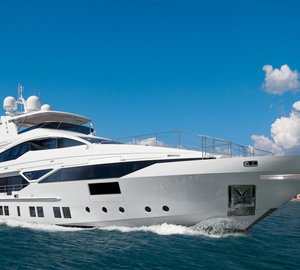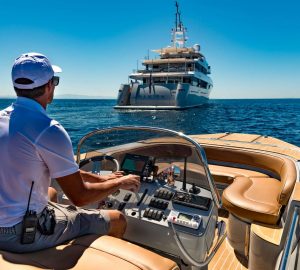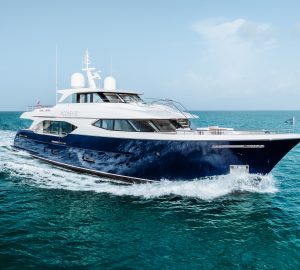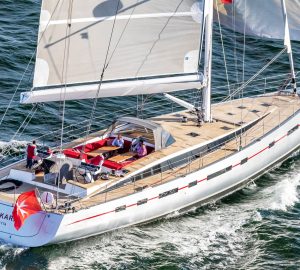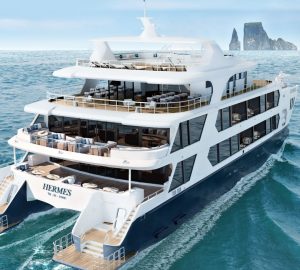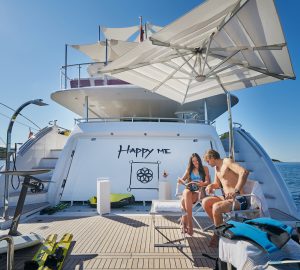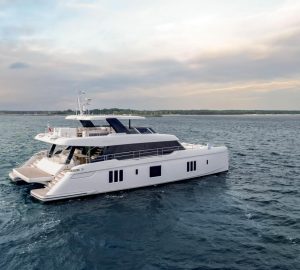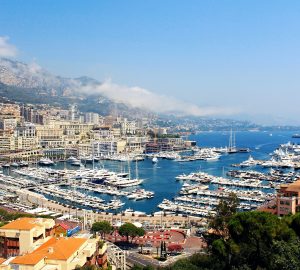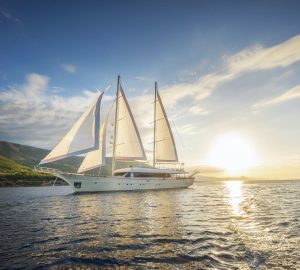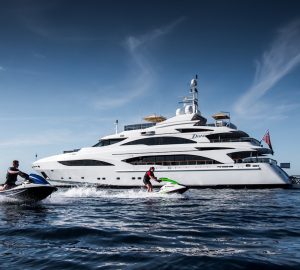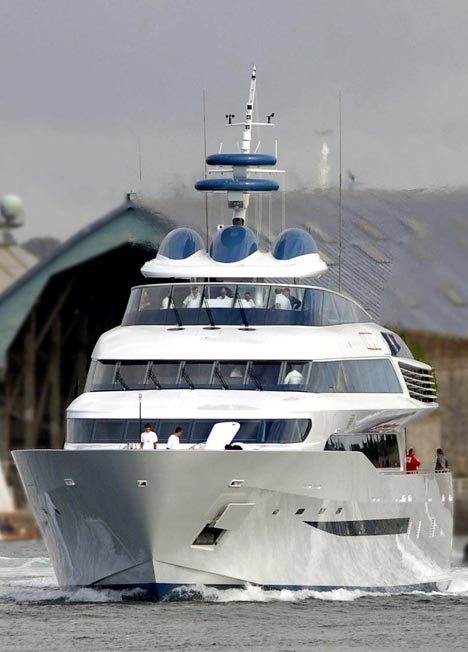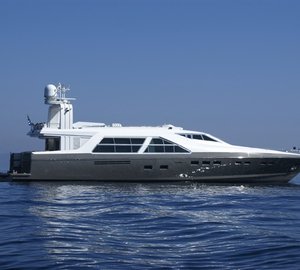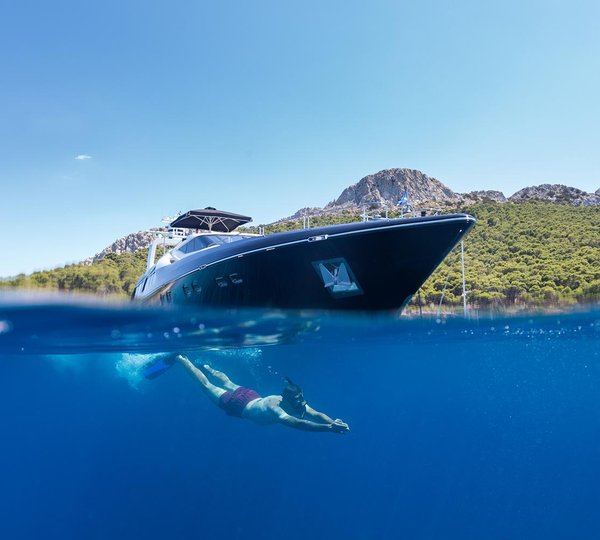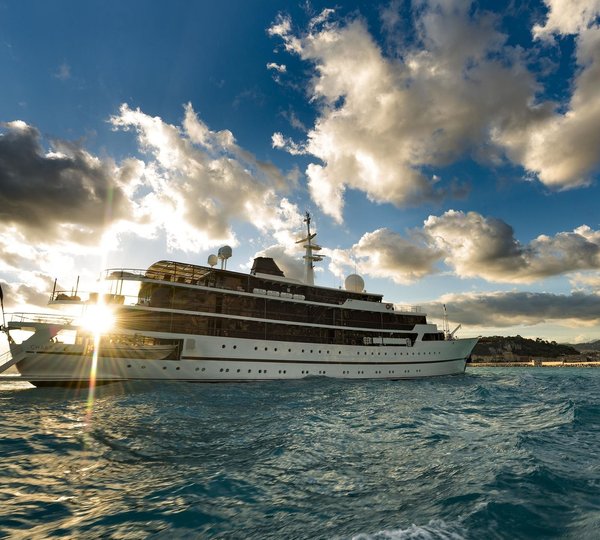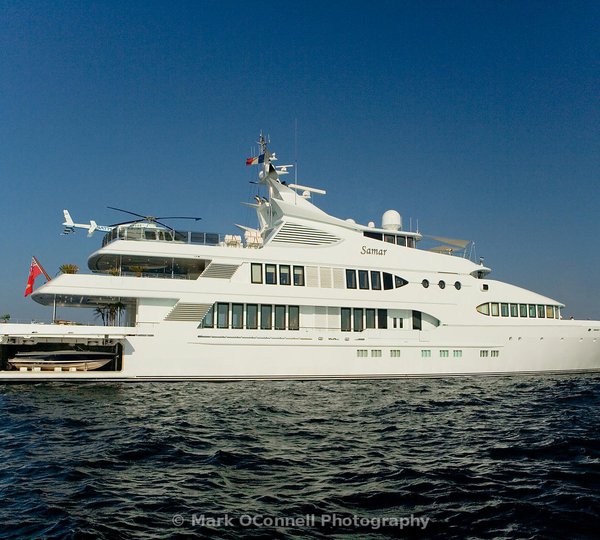The beautiful 50-metre motor yacht Alamshar (Project 305) has been successfully completed and delivered by Babcock’s Devonport Royal Dockyard facility, based in UK’s Plymouth. Superyacht Alamshar boasts a unique all-gas-turbine propulsion system, which comprises power by six gas turbines. With the control system and COGAG gears, this permits cruising with one to six engines, for the best fuel efficiency at any speed.
Two of the objectives of an all-gas turbine yacht were to achieve noise-free and vibration-free propulsion. These goals have been achieved to a remarkable degree. At the design stage, the Naval Architects, Donald Blount and Associates (DLBA) investigated a third objective. This concerned the aerodynamics of a vessel expected to be fast, – to develop wind-free spaces whenever the vessel was operated at high speed. This has been achieved both at the main deck level and the two decks above.
COGAG gears connect two gas turbines for a single shaft output power to a waterjet. The transmission of power to the waterjet may be from either connected turbine, or the combined power of both.
Luxury yacht Alamshar has been in construction for a protracted period due, in main part, to the technical challenges faced by the two manufacturers of the gas turbines, Pratt and Whiney and Rolls Royce. At the outset, different combinations of gas turbines were considered but the final choice came down to the Pratt and Whitney model ST40M, extensively used in the Norwegian Navy together with the Rolls Royce 601-KF11. Changes in the ship sets of the engines required substantial modification to the Renk reduction gears.
Being waterjet-propelled, the yacht is agile as it is very responsive to the throttle for speed changes and steering is very responsive as it manoeuvres by employing its two outboard water jets and its bow thruster. With the combination of gas turbines powering waterjets there is virtually no perceptible mechanical vibration, which complements this acoustically engineered yacht. Acoustic levels are extremely low for the comfort of the owner and guests, both in the interior and on deck. The surrounding environment near M/Y Alamshar remains quiescent as turbines operate. The vessel can be piloted from the bridge, flybridge, or main deck with portable joystick.
Super yacht Alamshar demonstrates innovative technology throughout the entire design of this outstanding yacht. It represents significant advances in propulsion efficiency, high-speed seakeeping, dynamic stability, acoustics, marine aerodynamics and the interface of operating crew with systems for safe high-speed navigation.
This advanced yacht development comes with DNV classification.
The Devonport Royal Dockyard of Babcock was awarded the contract to construct Project 305, now M/Y Alamshar, following an international restricted tender competition. The selection process involved the evaluation of many shipyards with a wide variety of project management technological skills. Babcock’s experience in supporting the Royal Navy surface and submarine fleet, together with its announced ability to develop industrial processes for the fabrication of the unusually light weight, high strength structure into which would be incorporated an innovative, in fact, first ever for civilian vessels, all gas turbine propulsion system, were all important factors in its selection. The state-of-the-art shipbuilding and systems integration technology required to deliver the vessel to specification would have doubtless proved demanding even if employed in a commercial or military vessel. They were especially challenging in Project 305, a pleasure yacht, in which an extremely high-performing noise abatement and vibration control programme had to be combined with speed, sea-keeping, comfort and an interior of light weight but high standard of fit and finish.
Throughout this meticulous combination of design development, preconstruction tank testing, all along the construction and periodic dock and sea trials throughout the construction process, it was not unusual, and was anticipated, that specific challenges would arise. In each such case, solutions and improvements have been developed and incorporated. The non-linear design development, a joint effort between naval architects, project management, the manufacturers of the elements of the unique propulsion system, the Classification Society, the expert technological advisers for noise and vibration abatement and Babcock, has resembled much more the development of a first-of-type military vessel or NASA project than might have been imagined by observers totally outside the project itself.
The naval architecture and engineering advances made strengthened the core knowledge base of DLBA, Babcock and S SPA. Development and interface of gas turbines (by two separate manufacturers) into the Renk gear box brought new technologies of smaller power density turbines to P&W and Rolls-Royce. The Classification Society, DnV benefited by lessons learned working with a motor yacht with such a high power density propulsion plant and Noise and Vibration advances were made by J&A, ISVR and Babcock.
In summary extensive hydrodynamic and aerodynamic programs were conducted to advance and develop new technology to achieve the performance capabilities of motor yacht Alamshar. This yacht exhibits exceptionally good ride quality in seas. Model testing in irregular waves validated new refinements to further improve double-chine hull, sea keeping which has been known for some time to be markedly superior to planing hulls. Further, the inclusion of systems for dynamic control of pitch and roll motions fine tunes ride quality.
M/Y Alamshar demonstrates innovative technology throughout the entire design of the yacht. It represents significant advances in propulsion efficiency, high-speed sea keeping, dynamic stability, acoustics, marine aerodynamics and the interface of operating crew with systems for safe high- speed navigation. The extensive model testing, investigation into propulsion system parameters and concomitant sea keeping research have led to a vessel which is capable of achieving 700 nautical miles at speed in excess of 45 knots at full load, 950 nautical miles at a transit speed of 35 knots, and 1040 nautical miles at 15 knots.
Many of the features of this high-speed, seaworthy yacht are expected to find their way into other marine service, possibly military and paramilitary operations.
PRINCIPAL INFORMATION – SUPERYACHT ALAMSHAR (PROJECT 305):
LOA 49.9 M (164 ft)
BOA 11.2 M (36.7 ft)
LOA/BOA 4.46
Hull Form double chine; planing
Hull Construction welded aluminum
Propulsion Machinery:
3 P&W ST40M gas turbines
3 R/R 601-KF11 gas turbines
3 BUSL 130/70-2 Renk – COGAG gears
3 KaMeWa 112 SII waterjets
900 NM range at 35 knots
Speed In excess of 45 knots
Builder Devonport Royal Dockyard Limited under the management of Babcock International Group PLC
Naval Architecture Donald L. Blount and Associates, Inc.
Exterior Styling Pininfarina
Interior Design Redman, Whiteley & Dixon
Sound & Vibration J & A Enterprises

